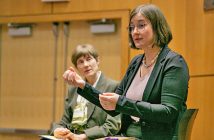The polemics of war and the politics of peace were front and center at the 2016 Spring McGinley lecture April 19 and 20.
Beneath the philosophical arguments was a deeply personal connection to the discussion, via the bloodshed that engulfed Ireland a century ago.
In Making War, Making Peace: Jewish, Christian, and Muslim Attitudes, Patrick J. Ryan, SJ, the Laurence J. McGinley Professor of Religion and Society, explored the ways in which Judaism, Christianity and Islam balance the fraught issue of when people have a right to wage war, and when not.
Divine Authorization
Regarding war in ancient Israel, Father Ryan said that Israel’s faith centered not only on liberation from bondage but also on divinely authorized territoriality. This meant the settlement of Abraham’s descendants in erez Yisrael, “the land of Israel.”
At the same time, Father Ryan said that Jewish faith also embraces a vision of God who has compassion not only for the people of Israel but also for their enemies. In the Talmud, God admonishes angels celebrating the Exodus, saying of the dying Egyptians, “My handiwork is drowning in the sea. Would you utter a song before me?”
Christian Principles for Just War
In the 5th century, Augustine was the first Christian theologian to develop a concept of just war, said Father Ryan. Medieval definition of just war, however, sometimes involved a certain “fatal subjectivity,” especially when Crusaders took up arms to fight Muslims as a form not of war but of doing penitential pilgrimage for their sins.
Thomas Aquinas offered three principles to define just war in the 13th century, said Father Ryan. One principle, “rightful intention,” presumed that just wars avenge injuries inflicted, a principle that is vulnerable to immense possibilities for misuse.
Father Ryan also quoted Aquinas to the effect that sometimes “‘war is declared by a legitimate authority and for a just cause, but is nevertheless rendered unlawful through a wicked intention.’”
As examples of wicked intentions and the wicked actions that flow from them, Father Ryan pointed to “enhanced interrogations” by the CIA in 2002 and the water boarding and sexual humiliation of enemy combatants by U.S. army personnel at Abu Ghraib in 2004, as well as the deployment of atomic bombs on Hiroshima and Nagasaki in 1945.
The Meaning of Jihad
Regarding Islamic faith, Father Ryan disputed the notion that jihad means “holy war.” Jihad originally denoted “struggle,” especially the struggle to recuperate what was lost when the prophet Muhammad and his companions had to leave Mecca for Medina. Jihad cannot justify terrorist violence, nor is it ever to be waged against fellow Muslims, as is done by ISIS.
Father Ryan singled out Bacha Khan, a 20th-century Pushtun from Pakistan, as the greatest Muslim pacifist struggler of the past century. Inspired by Mahatma Gandhi, Khan formed an unarmed Pashtun Muslim militia that practiced non-violence even when confronted with lethal force by the British in India.
Respondents to Father Ryan’s lecture included Sarit Kattan Gribetz, assistant professor of theology at Fordham, and Mehnaz Afridi, assistant professor of religious studies at Manhattan College. Professor Gribetz spoke about the homelessness war so often produces, citing the example of her own father’s lonely departure from Baghdad for Israel at the age of 8. Professor Afridi, a Muslim specialist on the Holocaust, spoke of the way Holocaust victims have tried to cope with the horrors of war they have experienced and have even thought of themselves as waging war to make peace.
A Family Narrative on the 100th Anniversary of the Irish Republic
Father Ryan began and ended his lecture with a family narrative about war and peace dating back to the Irish struggle for independence a hundred year ago. Because of wrongs inflicted against the Irish under British rule, the leaders of the 1916 Easter uprising argued that their struggle was just, said Father Ryan. They ascribed to the Provisional Government of the Irish Republic what Aquinas called “the authority of a ruler.”
“Both making war and making peace are arduous tasks,” Ryan contended. To illustrate this he detailed the history of a father in Tipperary taken hostage in the Irish war of independence by Harry Biggs, a much-hated British District Inspector, in retaliation against the father’s two IRA sons.
Biggs was ambushed and killed while driving on a country road on May 14th, 1921. A civilian passenger was also killed by accident—Winifred Barrington, the 25-year-old daughter of local British settler gentry. The man who killed Biggs, said Father Ryan, was the older son of the hostage Biggs had maltreated.
Elected to Dail Eireann in the subsequently created Irish Free State, the man who shot Biggs refused to take the required oath of allegiance to the King. Emigrating to New York in 1929, he married and started a family, but died in 1944, just after his 45th birthday.
Father Ryan concluded his presentation with a prayer for the dead. “May the souls of the signers of the Proclamation executed a century ago this spring, the souls of Winifred Barrington and Harry Biggs, and the soul of the man who shot Biggs in May 1921—my father, Paddy Ryan ‘Lacken’—rest at long last in peace.”



